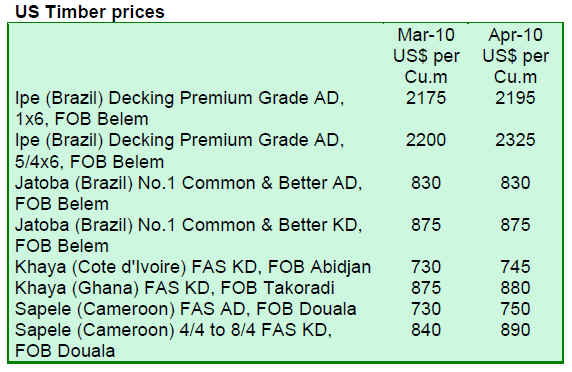|
Report
from
North America
Wood species in flooring
A recent survey of floor covering dealers and contractors by National Flooring Trends found that red oak remains by far the best selling species at 45% of the total floor cover sales. The other top wood species in flooring are hickory (13%), white oak (11%), Brazilian cherry (10%), maple (9%) and Brazilian walnut (3%). The floor width most often purchased is 3 to 5 inches.
Survey respondents thought that imported finished flooring was about twice as likely to have product quality issues as flooring made in the US. The 2010 NFT Hardwood Study also found that more than half of the respondents expect residential sales to increase in 2010. Respondents were somewhat less optimistic about the commercial flooring market, but most do not expect a decline in 2010.
Positive outlook for residential flooring and millwork markets
Lumber demand from flooring manufacturers is good and prices have increased, partly because of low availability according to the Weekly Hardwood Review. While many hardwood flooring plants have closed or cut production, several large manufacturers were able to increase production and sales.
The high number of foreclosures provided an unexpected market for hardwood flooring. Many home buyers took advantage of low home prices, mortgage rates and the recently expired home buyers tax credit to buy foreclosed homes where they installed new flooring, according to Import/Export Wood Purchasing News.
The hardwood moulding and millwork markets were hard hit by the recession, especially in commercial construction and remodelling. Less costly MDF and softwood products continued to substitute hardwood mouldings. Residential demand for mouldings has improved slightly in 2010, along with the demand for wood flooring.
Slow recovery in the furniture market
While the bad economic news from Europe has been continuous and unemployment figures have not declined as much as expected, the US consumer confidence on furniture purchasing appeared to improve.
Residential furniture orders and shipments continued to improve in March 2010 according to the latest survey of residential furniture manufacturers and distributors by the accounting and consulting firm Smith Leonard in High Point, North Carolina. New furniture orders in March 2010 were up by 9% compared to the previous year and by 2% from February 2010. 61% of the survey participants reported higher order rates for the month over last year.
Furniture shipments increased for the fourth month in a row in March. Year-to-date shipments are 5 percent higher than the first quarter of 2009. However, shipments are still below 2008 levels. Manufacturers¡¯ inventories fell by 5% from February, and there is little excess inventory left from when the market declined in 2009.
US imports of wooden furniture declined by about the same rate as domestic production, suggesting that the growth in market share of imported furniture is slowing.
US economic update
The US Commerce Department reported that consumer spending did not grow in April. This is in contrast to the first three months of the year when spending grew at an annual rate of 3.5%, the highest in seven years. Economists disagree about the cause of the dip in spending and also about whether consumer spending will remain low or pick up again in the coming months. Consumer spending accounts for about 70% of total US economic activity.
The European financial crisis and the resulting declines in the US stock market have joined the list of other concerns of many consumers: job uncertainty, high unemployment, mounting US federal debt and uncertainty over health care.
The May employment figures were much lower than expected. The US Labor Department reported 41,000 new jobs in the private sector, sharply down from 218,000 in April and the lowest increase since January. A spike of new jobs (411,000) came from the government hiring temporary census workers.
Canada economic update
In Canada, net employment rose by 25,000, which is the fifth consecutive month of increases according to Statistics Canada. On June 1st, Canada central bank increased its key interest rate by a quarter point to 0.50%. While this makes Canada the first of the G-7 industrialized nations to raise its interest rate since the financial crisis started, the rate remains very low. The Canadian economy grew 6.1% in the first quarter of this year, prompting the interest rate hike.
Canada is recovering faster from the recession than the US since it did not experience the housing market and mortgage meltdown or the failure of major financial institutions. While the central bank noted that the impact of Europe¡¯s debt crisis on Canada was limited to a decline in commodity prices, uncertainty in global markets continue to affect economic recovery.

Related News:
|